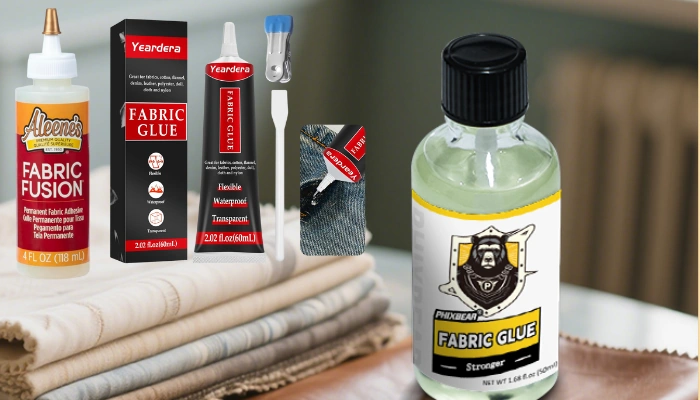When it comes to repairing, customizing, or embellishing clothing, not all adhesives are created equal. The right fabric glue must deliver a reliable bond, remain flexible after drying, and survive washing without compromising the look or feel of the garment. In this guide, you’ll find 13 of the best fabric glue for clothes of 2025 – 2026, each reviewed in depth so you can pick the perfect one for your project’s fabric type, wear pattern, and durability requirements.
13 Best Fabric Glue for Clothes (2025 Edition)
With dozens of products on the market, it can be overwhelming to pick the best one. That’s why we’ve tested and reviewed 13 top fabric glues and included an Ultimate Buyer’s Guide of best-selling, top-rated fabric glues to help you choose the perfect glue for your needs.
1. Aleene’s Fabric Fusion Permanent Fabric Adhesive

Type & Bond:
A water-based, permanent adhesive that creates a flexible bond between fabrics — ideal for garments, trims, and embellishments.
Key Features:
- Non-toxic and washable after curing.
- Dries clear with no yellowing over time.
- Works on cotton, denim, flannel, polyester blends, and more.
Application Tips:
Apply a thin, even coat and let it dry for 2–4 hours before washing. Use clips or weights to keep fabrics aligned.
Strengths:
Extremely versatile and long-lasting, with a natural feel on fabric once dried.
Limitations / What to Watch:
Takes longer to dry than instant adhesives, so not ideal for urgent fixes.
Ideal Use Cases:
Attaching appliqués, hems, and trims without sewing; ideal for T-shirts, jeans, and craft fabrics.
2. Gorilla Fabric Glue
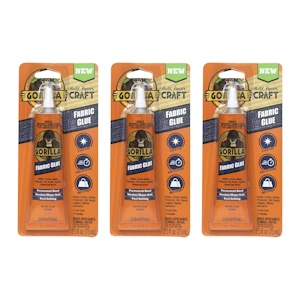
Type & Bond:
Instant-setting, strong, and flexible adhesive formulated specifically for fabric, felt, and leather. Gorilla Glue product information
Key Features:
- Sets quickly in 1–2 minutes.
- Fully washable after 24 hours.
- Resistant to moisture and heat.
Application Tips:
Apply sparingly; a little goes a long way. Press firmly for 30–60 seconds.
Strengths:
Outstanding instant bond strength — perfect for heavy fabric or outdoor gear.
Limitations / What to Watch:
Because of the fast setting, you get little time to reposition materials.
Ideal Use Cases:
Quick fixes for denim, leather, or canvas; outdoor clothing and gear repair.
A strong glue is only part of a good finish pairing it with the right thread matters too. Learn more in our sewing thread guide.
3. Tear Mender Instant Fabric & Leather Adhesive
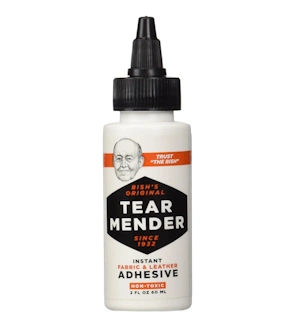
Type & Bond:
Latex-based, permanent adhesive that bonds instantly and remains flexible.
Key Features:
- Bonds in 3 minutes and washable in 15 minutes.
- Non-toxic, made from natural latex.
- UV-resistant and waterproof.
Application Tips:
Best applied on clean, dry surfaces; press gently until bond forms.
Strengths:
Fastest-drying option for real-world, on-the-go repairs.
Limitations / What to Watch:
May cause stiffness on thin or sheer fabrics.
Ideal Use Cases:
Repairing leather jackets, upholstery, or fabric tears while traveling.
4. Beacon Fabri-Tac Permanent Adhesive
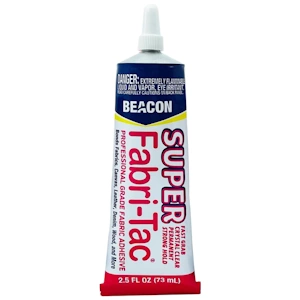
Type & Bond:
Premium, crystal-clear industrial adhesive for fabric, lace, leather, and wood.
Key Features:
- Quick-grab formula dries in 10 minutes.
- Machine-washable and flexible after curing.
- Works on trims, ribbons, and canvas.
Application Tips:
Apply a thin line; let it tack for 30 seconds before pressing.
Strengths:
Professional-grade clarity and precision — perfect for decorative work.
Limitations / What to Watch:
Contains acetone; use in ventilated areas.
Ideal Use Cases:
Costume design, home décor, and embellishments require clean, invisible seams.
5. Dritz Unique Stitch Fabric Glue
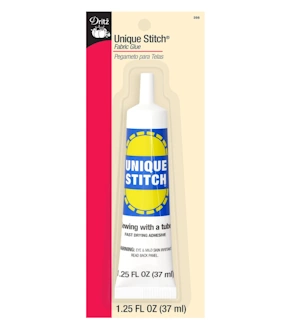
Type & Bond:
Sewing-substitute adhesive ideal for hems and trims.
Key Features:
- Dries clear, flexible, and washable.
- Works well on cotton and blends.
- Non-toxic and water-soluble before drying.
Application Tips:
Apply to one side, press together, and let dry for 30 minutes.
Strengths:
Great for beginners or temporary fabric holds.
Limitations / What to Watch:
Not strong enough for thick or heavy fabrics.
Ideal Use Cases:
No-sew hemming, quick DIY alterations, craft fabrics.
6. Permatex Fabric Repair Adhesive

Type & Bond:
Industrial-grade adhesive designed for automotive and heavy-duty fabric repair.
Key Features:
- Withstands heat, moisture, and washing.
- Bonds vinyl, canvas, and upholstery.
- Flexible once cured.
Application Tips:
Clean surface with alcohol before applying. Allow 24 hours curing for max hold.
Strengths:
Extremely durable, great for outdoor and car interiors.
Limitations / What to Watch:
Overkill for lightweight garments.
Ideal Use Cases:
Repairing car seats, luggage, or tents; not just for clothes.
7. Elmer’s CraftBond Fabric & Paper Glue
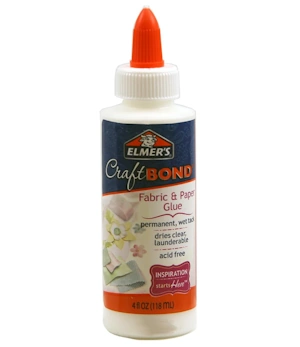
Type & Bond:
Dual-purpose craft adhesive that bonds fabrics, felt, and paper securely.
Key Features:
- Non-toxic and acid-free.
- Washable and dries clear.
- Smooth, non-clumping formula.
Application Tips:
Perfect for kids’ crafts or light fabric decoration; apply thinly.
Strengths:
Safe, affordable, and beginner-friendly.
Limitations / What to Watch:
Not suitable for high-stress fabric seams.
Ideal Use Cases:
Fabric crafts, school projects, and light clothing embellishments.
8. E6000 Fabri-Fuse Adhesive
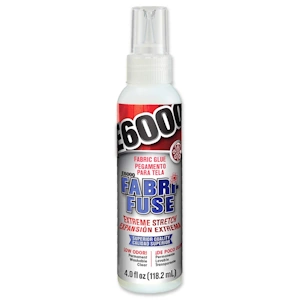
Type & Bond:
Industrial-strength, flexible adhesive ideal for permanent bonding.
Key Features:
- Dries clear and stretchable.
- Resistant to water and heat.
- Bonds fabric, felt, lace, and beads.
Application Tips:
Apply and press; let cure overnight for best durability.
Strengths:
Professional performance for costumes and dancewear.
Limitations / What to Watch:
Has a strong smell during use.
Ideal Use Cases:
High-stress costumes, shoes, and accessories.
9. Sewline Fabric Glue Pen
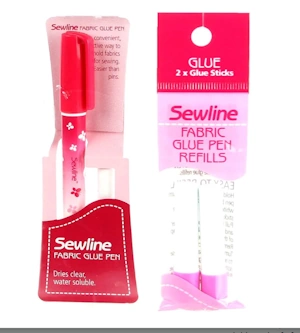
Type & Bond:
Temporary fabric adhesive stick designed for sewing preparation.
Key Features:
- Mess-free and repositionable.
- Water-soluble; disappears after washing.
- Ideal for patchwork and appliqué alignment.
Application Tips:
Apply sparingly to seams; reapply as needed.
Strengths:
Precision and control for quilters and tailors.
Limitations / What to Watch:
Not for permanent fixes.
Ideal Use Cases:
Basting seams, quilting, and fabric alignment before stitching.
10. 3M Super 77 Multipurpose Adhesive
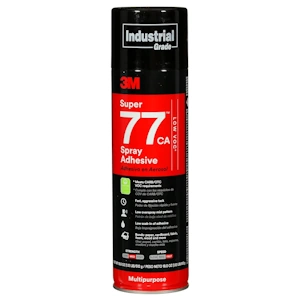
Type & Bond:
Spray-on adhesive for fabric, foam, and paper — great for large surfaces.
Key Features:
- Fast tack and strong hold.
- Even spray pattern reduces oversaturation.
- Bonds a variety of materials.
Application Tips:
Spray lightly 6–8 inches away; press fabrics together immediately.
Strengths:
Covers large areas evenly and quickly.
Limitations / What to Watch:
Not washable — best for decorative or craft fabrics.
Ideal Use Cases:
Costume props, backdrops, and fabric displays.
11. Singer Sew No More Fabric Glue
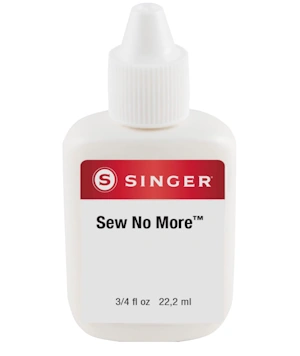
Type & Bond:
Quick-drying, no-sew solution from the iconic sewing brand.
Key Features:
- Dries clear and soft.
- Washable and flexible after 24 hours.
- Works on most clothing fabrics.
Application Tips:
Apply to small areas; let cure completely before laundering.
Strengths:
Trusted brand reliability with easy usability.
Limitations / What to Watch:
Not ideal for thick seams or leather.
Ideal Use Cases:
Hems, patches, and decorative trims on everyday wear.
12. Loctite Vinyl, Fabric & Plastic Flexible Adhesive
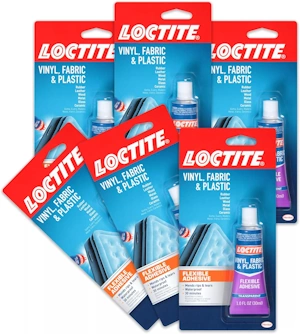
Type & Bond:
Water-resistant, clear adhesive for vinyl and synthetic fabrics.
Key Features:
- Flexible bond with water resistance.
- Ideal for synthetics, vinyl, and coated fabrics.
- Transparent, non-brittle finish.
Application Tips:
Apply a thin layer; let dry 2–3 hours for best adhesion.
Strengths:
Exceptional hold on non-porous fabrics and gear.
Limitations / What to Watch:
Less suitable for natural fibers like cotton.
Ideal Use Cases:
Raincoats, outdoor covers, and synthetic sportswear.
13. Beacon Felt Glue
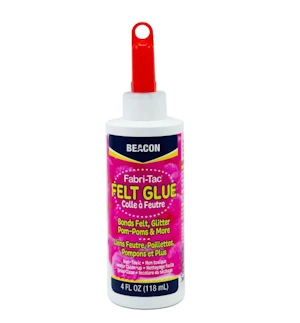
Type & Bond:
Specialized adhesive formulated for felt and plush fabrics.
Key Features:
- Non-run formula for thick fabrics.
- Dries flexible and soft.
- Safe for kids’ crafts.
Application Tips:
Press and hold for 30 seconds; dries in 1 hour.
Strengths:
Excellent for dense or layered materials.
Limitations / What to Watch:
Not as strong for smooth or slippery fabrics.
Ideal Use Cases:
Felt crafts, plush toys, and fabric decorations.
What is Fabric Glue & When to Use It
Fabric glue (also called fabric adhesive) is a specially formulated adhesive designed to bond textiles and fabrics. Unlike general craft glues, fabric glues are optimized for:
- Flexibility (so the fabric still drapes naturally)
- Washability (so the bond survives laundering)
- Clear drying (so the bond is aesthetically invisible)
- Compatibility with different materials (cotton, denim, polyester, leather, etc)
You might use fabric glue when:
- You want a quick fix for a hem, tear, or patch and don’t want to sew.
- You’re doing a no‑sew craft/fashion DIY and need adhesive rather than stitching.
- You need to bond embellishments (beads, sequins, lace) to clothing.
- The repair must survive washing and wearing.
According to guidance, testing on a small sample is wise: “Most glues … should last for at least several washings and wearings.”
Types of Fabric Glue
Understanding the different kinds of fabric glue helps you pick the perfect one for your project. Not every adhesive is suited for every fabric or purpose — here’s a breakdown of the main types:
1. Permanent Fabric Glue
This glue forms a long-lasting bond that stays through multiple washes and wears. It’s ideal for clothing repairs, heavy fabrics, and professional crafting. Examples include Aleene’s Fabric Fusion and Gorilla Fabric Glue.
Best for: Garments, denim, canvas, leather.
2. Temporary Fabric Glue
A removable, non-permanent adhesive that allows repositioning or washing out later. Commonly used for quilting, patchwork, and sewing preparation.
Best for: Sewline Glue Pen, basting seams, and embroidery layouts.
3. Heat-Activated Fabric Glue
Requires an iron or heat press to activate. It’s often used for hemming tape or iron-on patches, forming a strong bond once cooled.
Best for: Quick hems, patching, and no-sew home décor.
4. Spray Fabric Adhesive
Perfect for large fabric surfaces or layering projects. Easy to apply evenly and often used in upholstery, costume making, or crafts.
Best for: 3M Super 77 or any large-surface textile work.
5. Specialty Fabric Glue
Includes glues designed for specific materials — like leather, vinyl, or felt. These offer customized bonding strength and flexibility.
Best for: Tear Mender (leather), Beacon Felt Glue (felt), Loctite Vinyl & Fabric Adhesive (synthetics).
How to Choose the Right Fabric Glue
Here are the key features to check when selecting fabric glue:
Washability & durability
Make sure the glue is marked “washable” or “machine‐wash safe”. Some adhesives are only suitable for hand-washing or decorative use.
Fabric type compatibility
Different fabrics behave differently. A glue that works well on heavy denim may not work as well on fine silk or stretch fabric.
Drying time & flexibility
Faster drying is a plus for quick repairs, but the glue should still leave the fabric flexible (not stiff or crunchy) after curing.
Clear vs visible finish
If your repair is on a visible area, you’ll want the glue to dry clear and not leave yellowing or show-through residue. Many crafters emphasize this
Application method
Some glues are squeeze‑tube liquid, others are spray adhesives, fabric tape, or iron‑on adhesives. The method affects ease of use, precision, and messiness.
Safety, smell & toxicity
Especially if you’re working on kids’ clothes or sensitive skin fabrics, check that the product is non‑toxic, low‑odor, and safe to use.
How to Use Fabric Glue – Step By Step
- Prepare the fabric – clean and dry the area, remove loose threads, and flatten the fabric.
- Test on a small patch – especially if working on a delicate or visible fabric.
- Apply sparingly – don’t soak the fabric; a thin layer is often enough.
- Press & align – bring the two pieces together accurately; use weights or clamps if needed.
- Allow to cure fully – follow manufacturer instructions for drying time (often 24 h before washing).
- Wash care – wash with similar colors, gentle cycle if possible, and avoid high‑heat drying until you’re confident the bond is stable.
Ultimate Buyer’s Guide to Fabric Glue (2025)
Choosing the right fabric glue depends on your fabric type, project purpose, and required durability. Here’s everything you need to know before buying.
1. Fabric Compatibility
- Natural fabrics (cotton, linen, wool): Go for water-based glues like Aleene’s Fabric Fusion.
- Synthetic fabrics (polyester, nylon, vinyl): Choose a flexible, solvent-based glue such as Loctite Vinyl & Fabric Adhesive.
- Leather or heavy materials: Pick a strong industrial formula like Gorilla Fabric Glue or Tear Mender.
If you often work with thick or layered fabrics, a walking foot sewing machine ensures smoother stitching alongside strong fabric glue bonding.
2. Drying and Curing Time
If you need instant results, Tear Mender or Gorilla offers rapid bonding in under 5 minutes.
For precision work, slower-drying options like Aleene’s give you more control for alignment before the glue sets.
3. Flexibility After Drying
Clothing requires flexibility to prevent cracking or stiffness. Always check if the glue remains stretchable and soft after curing — like Fabri-Tac or E6000 Fabri-Fuse.
4. Washability & Durability
If your project will be machine-washed, select glues labeled as washable or waterproof.
✅ Top washable picks: Aleene’s, Tear Mender, E6000, and Singer Sew No More.
5. Ease of Application
Consider how you’ll apply the glue:
- Tubes: Precise for small areas (Aleene’s, Fabri-Tac).
- Pens: Great for beginners or quilters (Sewline).
- Spray cans: Efficient for large projects (3M Super 77).
6. Safety & Non-Toxic Formulas
For household or children’s use, opt for Elmer’s CraftBond or Aleene’s Fabric Fusion — both non-toxic and odorless.
7. Budget & Size Options
Fabric glues range from $4 craft tubes to $15 professional bottles.
If you craft regularly, larger bottles of Fabri-Tac or E6000 offer better long-term value.
🧠 Pro Tip:
Always test your fabric glue on a small hidden section before applying it to the main area. This ensures no discoloration or stiffness appears once it dries.
Frequently Asked Questions (FAQ)
Q: Can fabric glue replace sewing completely?
A: It depends on the application. For minor repairs (hemming, attaching patches), yes, many users find a good glue sufficient. However, for structural seams or garments under heavy strain, sewing typically provides stronger long‑term durability.
Q: Is fabric glue machine‑wash safe?
A: Only if the product states “washable” or “machine‑wash safe”. Always follow the curing instructions before laundering. Many glues claim multiple washes.
Q: Will the glue make my fabric stiff or visible?
A: The best fabric glues dry clear and flexible, but misuse (applying too much, using the wrong glue for the fabric) can cause stiffness, visible residue, or yellowing. One reviewer flagged the smell of the glue as a small downside.
Q: Can I use fabric glue on leather or vinyl?
A: Some products (Tear Mender, Nayrmaer, Gorilla) are designed for mixed materials, including leather and vinyl. Always check compatibility.
Q: How quickly does it dry? When can I wash?
A: Drying times vary by product—some claim minutes (e.g., Aleene Quick Dry) while others might require 24 24-hour cure for washing. Always follow manufacturer instructions.
Tips & Tricks from the Field
- Use thin layers rather than heavy globs. Heavy glue can seep through fabric or leave bumps.
- Press the glued area under something flat (book, ruler) during curing to ensure even contact.
- For visible repairs, choose a glue with a clear finish and minimal odor. One community said: “Best fabric glue ‑ Beacon Fabri Tac … dries quickly and no stains.”
- On heavy fabrics (denim, canvas), let the glue cure fully before the first wash and avoid the high‑heat dryer initially.
- If the fabric is stretchy or activewear, test the glue with stretching after curing to ensure the bond holds.
- Store glue upright, cap it tightly, and clean the nozzle tip to avoid clogging (especially sprays).
- In Morocco (and worldwide), if shipping/importing a glue product, check customs/import regulations for chemicals or adhesives.
Conclusion & Final Recommendations
If you’re choosing just one fabric glue now, pick based on your use case:
- For everyday garment repairs → Beacon Fabri‑Tac Permanent Fabric Adhesive
- For quick, no‑sew fixes → Aleene’s No‑Sew Temporary Fabric Glue
- For budget and frequent use → generic Permanent Clear Washable Clothing Fabric Glue
- For heavy fabrics/leather/outdoor gear → Gorilla Fabric Glue or Tear Mender
Be sure to test on a small area, allow proper curing time, and follow care instructions. With the right glue and good technique, you can make durable, invisible repairs or craft stylish no‑sew fashion with confidence.
For bigger repairs, pair your glue work with a powerful machine like the Singer Heavy Duty 4452 perfect for denim, canvas, and leather.

Hi, I’m Safura. What are you sewing today? If you have any questions or need help with anything related to sewing, please feel free to ask. I’m always here to assist you with sewing-related issues.

